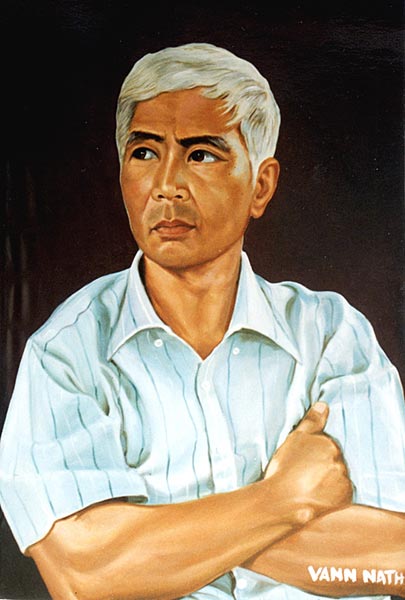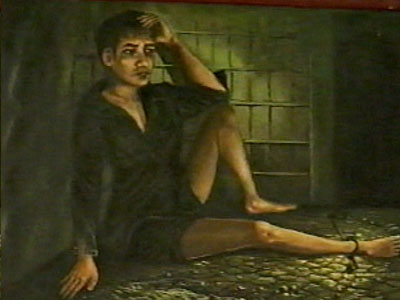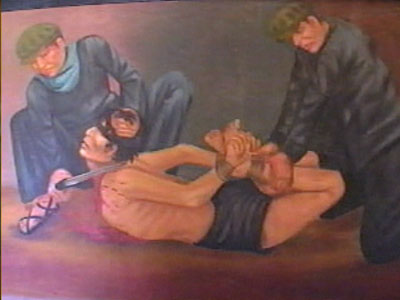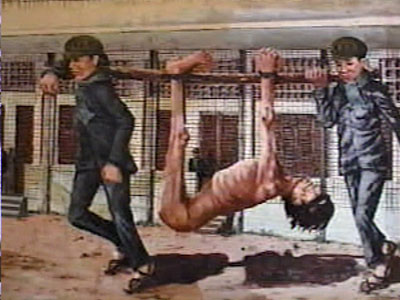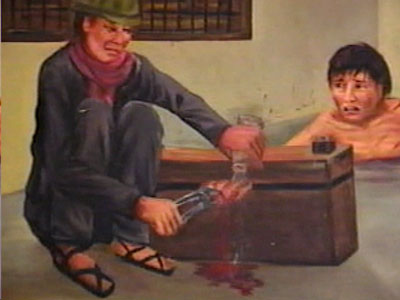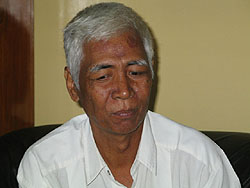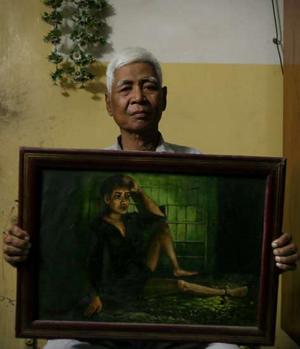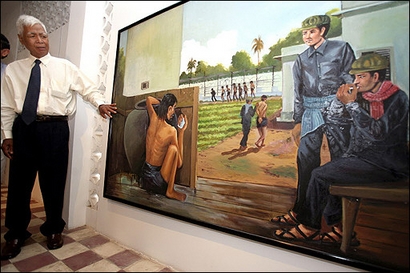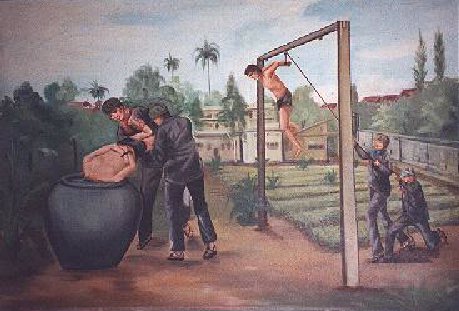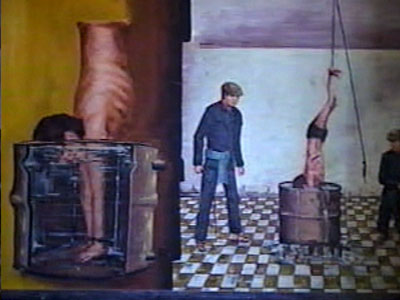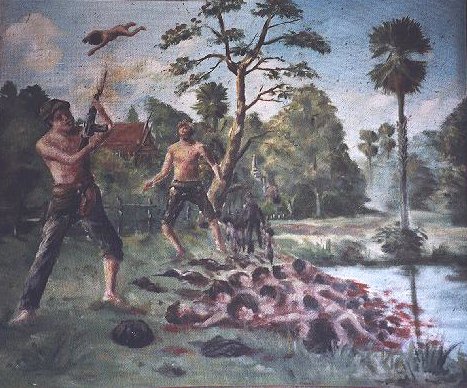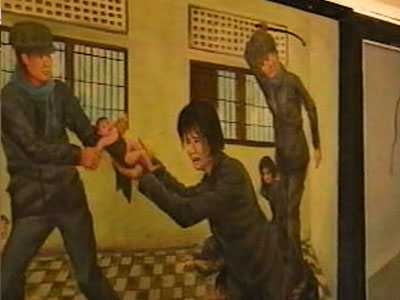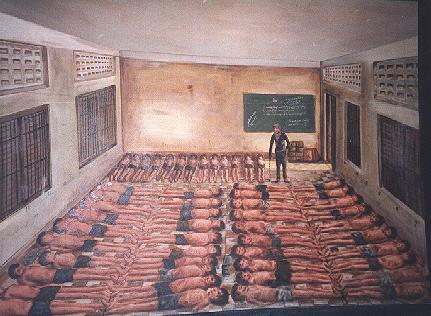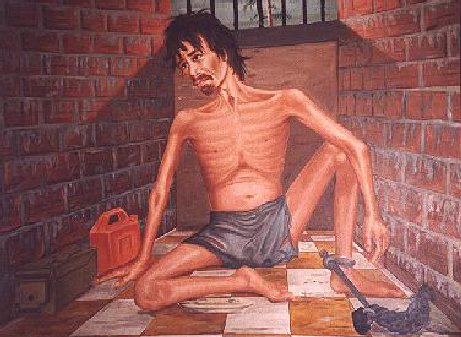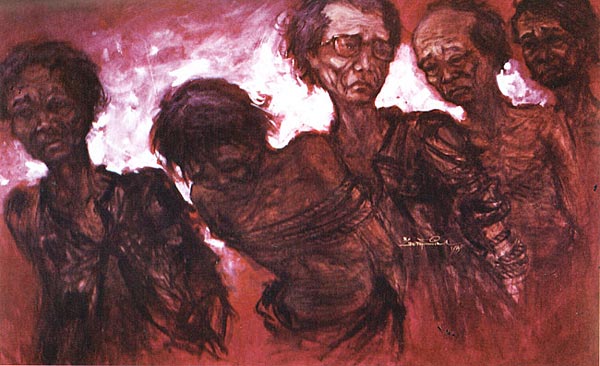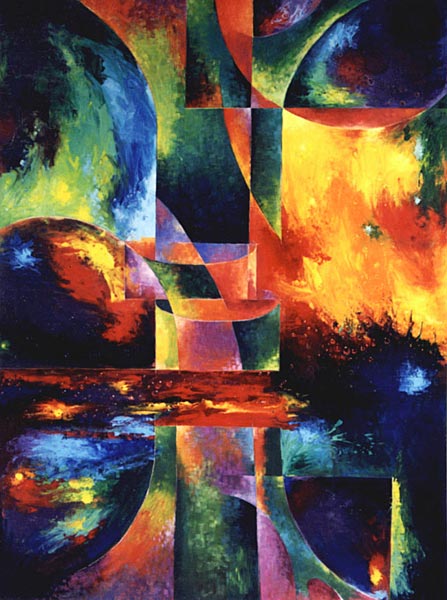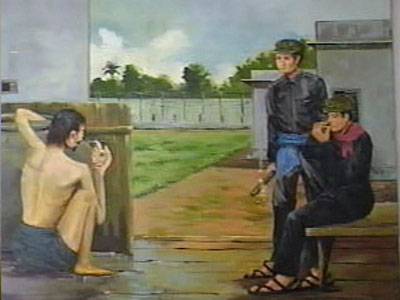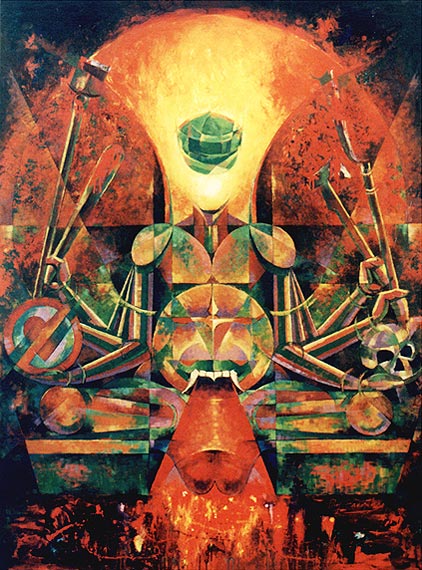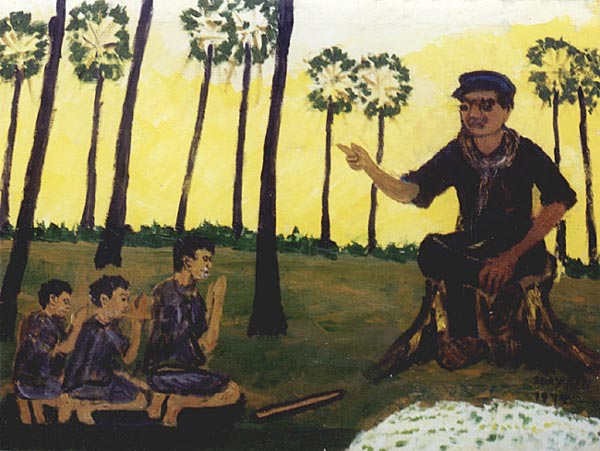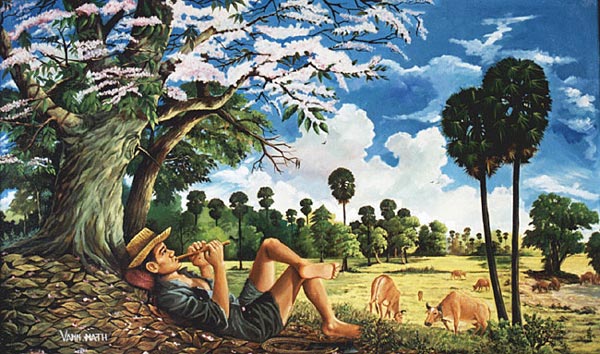| Vann Nath
The Art History Archive - Asian Art
Paint Propaganda or DieVann Nath grew up in Wat Sopee in Battambang province. His parents were separated and he had two brothers and an older sister. They survived by selling the Khmer noodle called the 'noop bangchop'. They were so poor that Vann Nath didn't have a chance to get an education. By the time he was 14 or 15 he was working at factory jobs for 500-600 riel a month (less than 25 cents). He became interested in painting while he was a youngster in school, "I became very attracted to painting when I went into the pagoda and I saw people painting a picture on the side of the wall of a temple." But instead of pursuing painting he served as a monk from the age of 17 to 21. "Every family has a son...one of the sons must go and serve as a monk - it is considered bad for the Cambodian family to not have a son who is a monk", says Vann Nath. When his sister passed away, Vann Nath left the monk hood to do something which would help support the family. He enrolled in a private painting school in 1965,"School was far from my house and I couldn't afford a bicycle. Because our family life was hard, only my mother was working to support the whole family and she became older and older and I had to pay the tuition for the painting school." Later, the school allowed Vann Nath to work there instead of paying tuition. After two years he was able to profit from his own painting work. At the time of his arrest on January 7, 1978, Vann Nath was working in a rice field in his home province of Battambang like many other Cambodians. The Khmer Rouge took him to Wat Kandal, a Buddhist temple used as a detainment centre. They told him that he was accused of violating the moral code of the organization of Angka. He wasn't clear what that meant.
They interrogated him later that night, "I was very, very confused because they asked me what network of betrayal I was in and whom I had relationships with, but I was confused because they used live electrical wire on me and I fell unconscious a few times." A week later he was loaded into a truck by the Khmer Rouge and taken to Tuol Sleng. Once there they took a mug shot and measured his height. "After all of those things, I felt a little hope - Oh, my life would be spared because if they were doing all this process I thought I would not be killed." Vann Nath still has that picture of himself. They took him to the D room on the third floor where about 50 people were shackled together. He was forced to lie down and could only sit if he asked the guard for permission. The guards would provide a metal bucket for the prisoners to urinate in. Food was served at 8AM and 8PM. Each meal consisted of two or three tablespoons of rice porridge. They were not given any water. Every three or four days the guards would hose the prisoners down. "It was like hell, I can't describe it. At that time, in that condition, the hope that I had earlier had disappeared," recalls Vann Nath.
Many people died and at night guards would come to remove the bodies. After a month in D room Vann Nath was removed from his shackles. He was taken to see Duch, the director of Tuol Sleng Prison. Duch showed him picture and asked him to paint a drawing from it. "It was a black and white picture and that is not my area of specialty so I told him if I could paint it I would but I didn't know how I would do it with black and white, but I will try very, very hard to do it." Propaganda pictures that Vann Nath painted of the Khmer Rouge leader, Pol Pot. Every day Duch would visit Vann Nath and give him encouragement. He was allowed to sleep on the floor in the room where he was painting. Vann Nath painted pictures of propaganda for the Khmer Rouge, including several portraits of Pol Pot. Vann Nath was released from Tuol Sleng exactly one year later on January 7, 1979. After his release he looked for the other six survivors - most had skills such as carpentry and mechanics. He saw a list of the people who died at Tuol Sleng. He name was on the list, but beside it Duch had written "keep the painter." Vann Nath began painting scenes from Tuol Sleng in late 1979 and early 1980. Tuol Sleng was being turned into a museum and he wanted people to know what happened there. "What I saw while we were in the prison, was those people who used to scream for help. But we could not help them. I would like their souls to get something form what I paint." Today, Vann Nath is 56 and still working as a painter in Cambodia. He's working to build a retirement centre in Battambang where people who survived the Khmer Rouge regime can spend their last days in peace.
The Khmer Rouge
In 1975 the Khmer Rouge, under the leadership of Pol Pot, seized control of Cambodia. They were a communist, nationalist group who imposed a very specific type of Maoist cultural revolution on the population of Cambodia. In the view of the Khmer Rouge the peasant was the ideal citizen. The Khmer Rouge were deeply suspicious of urban life and of the bourgeois values inherent there. As a result, its policies included relocating the massive urban populations of Cambodia to the countryside in order to perform agricultural labour. Cities were evacuated. Schools were closed. Hundreds of thousands of people, from store clerks to taxi drivers were forced to work on agricultural communes. It is estimated that upon the Khmer Rouge's arrival in power the city of Phnom Penh had a population of between 1.5 and 2.5 million. Within weeks it was practically deserted. This animosity was particularly evident in the Khmer Rouge's treatment of the educated. It is well documented that thousands of people were summarily executed for no reason other than that they could read and write. Their families were then killed in order to suppress the possibility of revenge. The issue of mass killings is perhaps the most striking part of the Khmer Rouge regime. As many as 1.5 - 2 million people died during the regime (of a total population of about 7 million), and it is estimated that 200,000 or more of these deaths were by execution. In fact, the number of those who died during the time of the Khmer Rouge is not known for certain and could be even higher than this. The Khmer Rouge had detention centres throughout the country. The largest of these was called Tuol Sleng. As many as 17,00-20,000 people passed through its gates during the Khmer Rouge regime. All but 7 of them died. (Read the prison rules)
Vann Nath survived Tuol Sleng because the detention centre's keepers found it useful to keep him alive. This is because Vann Nath was a skilled painter. He was kept alive in order to paint propaganda portraits of the Khmer Rouge leader Pol Pot, and to do other types of artwork with similar purposes (including some sculpture). After the Vietnamese invaded Cambodia and the Khmer Rouge was ousted, Vann Nath spent a couple of years documenting in paint (through his paintings) the experiences he and others had had at Tuol Sleng. These paintings now hang in the Tuol Sleng building as part of the evidence of what went on there. That building is also a museum and documentation centre. It houses portraits of the Tuol Sleng victims and the documents kept by the Khmer Rouge of the tortured confessions obtained by them of the prisoners (before such prisoners were executed). The Khmer Rouge were finally ousted by a Vietnamese invasion, in January, 1979. Over four years of Khmer Rouge rule 1.5 million people died - 20% of the total population. There has been a series of attempts (or one attempt with many stops and starts) over the past 5-6 years to establish a tribunal to try those of the Khmer Rouge leadership still alive. The negotiations for such an institution have been carried on between the UN and the Cambodian government. The talks have been slow, in part because the two sides have not come to an agreement as to the scope of such a tribunal, the rules under which it would operate and (most importantly) the national make-up of the judges and prosecutors. This impasse can be explained partly by the fact that the current Cambodian leader, Hun Sen, was a junior level Khmer Rouge cadre during the time in question. He has also already made a deal with one of the top living KR leaders (Iang Sary) in which the latter is permitted to live in peace in Cambodia in exchange for dropping his armed resistance to Hun Sen's government. The notorious leader of the Khmer Rouge, Pol Pot, is reported to have died several years ago. The rise to power of the Khmer Rouge in Cambodia is a complicated story. It is part of the long history of French, American and Chinese influence in south-east Asia. Cambodia in many ways became a piece on the geopolitical chess board of the post-war cold war. The Khmer Rouge came to being out of a series of factors: the rise of communism as a powerful political ideology; the use by the superpowers of Vietnam as a staging ground for the American notion of Containment; the long-held antipathy and mistrust of Cambodians for their Vietnamese neighbors; and many others.
|
|
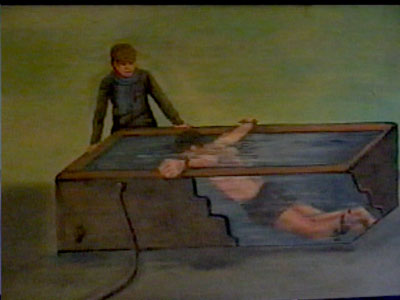
One Artist, One Million MemoriesBy Seth Mydans. PHNOM PENH, Cambodia — When Vann Nath was asked to paint his vision of the future, he chose his brightest colors and produced a lush bouquet of flowers, topped by a radiant butterfly. It was a bitter joke. The flowers make up a tiny corner of a painting that is filled with horror — a dark catalog of disaster and death, of war and suffering, with hungry vultures, flashes of lightning and piles of human skulls. "I just want to explain," said the painter, a striking white-haired man whose thick black eyebrows are white at the tips like the wings of a bird. "At any time, even when things seem good, everything can turn upside down. It makes you afraid to hope."
Mr. Vann Nath, 56, has lived through a torment that almost makes his painting and his pessimism seem an understatement. He is one of just seven people who survived the torture house, Tuol Sleng, where at least 14,000 people were sent to their deaths during the brutal rule of the Khmer Rouge from 1975 to 1979. He is one of only two of those survivors who are alive today. His bewildering gift, he says, was life. His curse is memory. "I want to forget," he said in an interview. "I try to forget, but it is useless. I can't forget even a small part of it. Even after 20 years, when I think of it, I can still feel terrified." There were screams in the morning and screams at night, he said: the screams of men being tortured — "screaming with all their might" — and the screams of children being dragged away from their mothers to be killed.
"When the screams got really bad, we just turned and looked at each other as if we had made an appointment," he said. "We were talking to each other with our eyes. We wanted to say, `Is this what will happen to us, too?' " Like most Cambodians, Mr. Vann Nath was born into a poor farming family that was wrenched apart and forced into work gangs when the Khmer Rouge came to power. Like many, he suddenly found himself arrested for reasons he says he still does not know. But like only a handful of prisoners, he possessed a talent that saved him: he had been a painter of movie billboards. When his name was called one day and his shackles were removed, he was led away not to be killed but to begin painting portraits of a man he did not recognize, Pol Pot, the Khmer Rouge leader. He was painting for his life; other men who had failed at the job had been executed. "Every brush stroke," he said, "you were just hoping that they would like it and would let you live." As he caressed the face of Pol Pot with a paintbrush, he could hear the screams of the victims.
In January 1979, when a Vietnamese invasion drove the Khmer Rouge from power, Mr. Vann Nath was one of a half-dozen prison workers who escaped in the tumult. In addition to the victims of the torture house, more than a million people had lost their lives through execution, starvation and hard labor. Cambodia was now a nation of traumatized survivors, along with those who had tormented them; nobody emerged undamaged. Their task now was simple, and crushingly difficult: to go on with life. At first, Mr. Vann Nath found himself back at his old prison, assigned once again to paint. This time his job was to portray not Pol Pot but his victims — scenes of torture and starvation to be shown in a Tuol Sleng museum. Then, free at last to face the future, he began to rebuild his world. He joined the military, became a painter of propaganda banners and worked as an architectural draftsman. Together with his wife, he opened a small restaurant selling coffee and plates of rice. He settled into a daily routine, hoping to sink back into the life of an Everyman.
But that, he found, was impossible. Wherever he went and whatever he did, Mr. Vann Nath was surrounded by the souls of the 14,000 fellow prisoners who had died, watching hungrily the life they had been denied. He had survived, but his life no longer belonged to him alone. In his simplest daily actions, he was the representative of the dead. He ate, he slept, he talked, he breathed for them. Imprisoned once again by his past, Mr. Vann Nath gave himself the task of telling his story — their stories — granting frequent interviews to researchers and reporters, and publishing a small, intense, vividly remembered book about his imprisonment. "By talking, I think I bring some ease to the people who died," he said. But not to himself. Every interview is an ordeal. Sometimes he stops in tears. Sometimes, he said, it takes days to recover from the newly stirred memories. His book, "A Cambodian Prison Portrait" (White Lotus Press, 1998), was even more difficult. "Sometimes I spent two weeks to write half a page," he said. Thinking about the future seems not to have been much better. His painting, commissioned by the Reyum Gallery here in Phnom Penh, revolves around the forlorn figure of a man praying for better times, or perhaps begging for mercy.
Mr. Vann Nath's pain is evident only when he talks about his hardships. A dignified and gracious man, he lives quietly and not uncomfortably with his wife of 31 years, who struggled through the forced labor of the Pol Pot years, and their three attractive children. His restaurant, now managed by tenants, provides a living. He spends his days at his easel on the rooftop patio of his downtown home, where a breeze rustles the leaves of plants and rattles a nearby metal awning. His mind has turned now to a new project to ease the lives of aging survivors while honoring their past. He has prepared a detailed proposal for a rest home where the old can be cared for and the young can come to learn from them. "I think those who went through the Pol Pot time have special knowledge," he said. "It is important to teach young people what they went through and what it means to suffer." That is a subject that has filled Mr. Vann Nath's thoughts for more than 20 years. It is the subject of his persistent memories, of his dreams and, inescapably, of his vision of the future. Late at night, he said, on the small patio where he now paints bland, bucolic scenes of farmers and fishermen, he likes to lie in his hammock alone and gaze at the sky and the stars. In his imagination, he escapes to a better world, as he did when he stared at the sky through the bars on the prison windows. "I look and I wonder if there is life on other planets and what it's like," he said. "Do they live like us? Do they suffer the way we do? Sometimes I think that if their lives are different from ours, if they don't have the suffering that we have — I think to myself that it must be really great to live on one of those planets."
Cambodian Artists Confront the PastBy Sarah Stephens An imposing Khmer Rouge commander sits in the lotus position on a rock, his right hand raised in the air in an unquestionable gesture of authority. Below him, on the ground, three small figures kneel in supplication, their hands held reverently in a sampeah, listening to the commander's words. The figures are primitively drawn and the detail rough, but the message is clear. The Khmer Rouge are the new religion, the usurpers of Buddhism. Across the gallery, a similar message is portrayed, but with a more menacing edge. On a towering canvas, the great machine of Angkar (the name the Khmer Rouge gave to their regime) is depicted in violent, clashing colors. The mechanical giant looms above the spectator, its legs tucked underneath itself and its six arms raised elegantly in a theological parody. But this is no benevolent god-in its hands are hoes, rakes, and other agricultural tools, all dripping with the blood of its victims.
The artists who have depicted these scenes are no trauma-voyeurs or bloodthirsty thrill-seekers. They are survivors of one of the twentieth century's most legendary and cruel regimes, the Khmer Rouge. Over a period of nearly four years, through their Mao-inspired agrarian revolution, Pol Pot's Khmer Rouge struggled to return Cambodia to "year zero," to eliminate the bourgeois, the capitalists, the educated middle class, and all other enemies of the state, including teachers, monks, writers-and artists. While Phnom Penh today buzzes with the ever-increasing possibility of a trial for the men and women who created the Khmer Rouge regime, a small group of artists have come together to tackle the Khmer Rouge legacy through previously unexplored channels. The result is a disturbing and thought-provoking exhibition, "The Legacy of Absence," shown at Phnom Penh's Reyum Gallery in January and February 2000.
"I know what happened during this time," says Phy Chan Than, who did the painting of Angkar. "I made this picture because I want all the world, especially Khmer descendants, to know about the Pol Pot time." Chan Than's massive, semiabstract canvases are unusual in Cambodia. Today most artists here follow a strictly commercial and unchallenging career path, choosing to paint saccharine images of Angkor, the spectacular and revered ancient temple complex that forms such a major part of Khmer consciousness, or soft-porn images of seminude women bathing in waterfalls. Chan Than, now a professor at Phnom Penh's University of Fine Arts, trained in Hungary when Cambodia was a communist state; the composition and colors in his paintings have a distinctly Western feel. "Most of the students who come to the exhibition to see my paintings cannot understand the abstract images," he says. "Some of them even refuse to believe that they were painted by a Khmer artist." One of his canvases, The Koh Tree, a wildly colored abstract, carries a detailed explanation beside it on the gallery wall, to help spectators understand the artist's intentions. In Khmer, explains Chan Than, the word for the Kabok tree is "koh," which also means "mute." During the Khmer Rouge era, an oft-repeated saying had it that, "If you want to live, plant a koh tree in front of your house." In other words, keep quiet if you don't want to die. "We had to remain silent about everything we saw, knew, or heard," says Chan Than. The Legacy of Absence exhibition in Phnom Penh includes the work of ten artists, and several of the works shown there will form part of a much larger, worldwide exhibition on the same theme, tentatively scheduled to open in May 2002 at Buchenwald Memorial, near Weimar, Germany. American art-lover and entrepreneur Clifford Chanin created the Legacy Project, a U.S.-based foundation, in order to draw together artists from countries that have suffered mass national traumas or genocides, leaving a great "absence" among the populace. Among the countries to be represented in the worldwide exhibition are Germany, Israel, Japan, China, Bosnia, the former Soviet Union, India, and Pakistan. "The idea of the exhibition is to try to understand the kinds of things that are missing after a mass murder or war, and to explore whether there is a way to fill the emptiness that the victims leave behind," according to Chanin.
Many of the countries approached for the exhibition already possessed a vast collection of genocide- or trauma-related works, but the organizers encountered an unusual problem when they approached Cambodia for exhibitors. "The only art works you ever see in Cambodia are the mass-produced paintings of Angkor," says Ly Daravuth, co-curator of the exhibition and one of the artists whose work is included in the show. "When you talk to the artists who produce them, they say they only want to produce beautiful things, that above all, their art should show beauty." Amazingly, there were almost no paintings of the Khmer Rouge regime by Cambodian artists before the Legacy exhibition was organized, even though the regime collapsed over twenty years ago. Many artists cite political fear as an overriding reason for not producing such art, but Daravuth thinks there may be a deeper reason. He believes that the absence of such a body of work is almost as powerful a statement as if the work had been created in droves. "The people just refuse to confront it so far," he says. "The artists do not want to contemplate it; it is too hard. Sometimes when you have a shock, you don't want to talk for a while. They just want to look back with nostalgia, and so they cling to these Angkor paintings."
Daravuth himself is a survivor of the Khmer Rouge years. As a young boy in the border camps of Thailand, he helped his uncle, Ngeth Sim, also an artist, prepare canvases. Sim was sent to France as a refugee, where he has lived ever since, but some of his paintings are being exhibited for the first time in Cambodia in the Legacy show. The Last Look is a deeply disturbing sketch of the artist's father just before he was led to his execution. Painted in deep hues of magenta and blood red, the canvas shows five emaciated, semi-naked men, resigned to death, their spirits completely broken. Four have their eyes fixed on the ground, but one, wearing glasses, turns to look sadly over his shoulder. "My poor father, at the moment when the Khmer Rouge led you away, I fixed on your face intently," writes Ngeth Sim. "I did not have the force to protest in front of these torturers, to prevent them from taking you and killing you. . . . Dearly beloved father, I pray every night that your soul will pardon me." One of the few exhibitors who had created art depicting the cruelty of the regime before the Legacy Project approached him was Vann Nath, one of Cambodia's leading contemporary artists. Nath was one of eight known survivors of the notorious Khmer Rouge detention center, Tuol Sleng, in which around 16,000 men, women, and children were systematically tortured and executed. Now fifty-four years old, he is the only one of those eight survivors who is still alive today. He is best known for his series of paintings made in 1980-81 depicting his time as a prison painter. (Because of his artistic abilities, he was forced to spend his time in prison turning out portraits of Pol Pot.) Today, Nath, a distinguished and gentle-looking man, whose shock of thick white hair makes him stand out amongst the rest of his countrymen, lives quietly in Phnom Penh. He paints very little now, but acknowledges his unique position as sole surviving witness of Tuol Sleng. Yet his eyes darken when he speaks of his time at the center, and although he granted an interview for this article, he rarely talks to journalists.
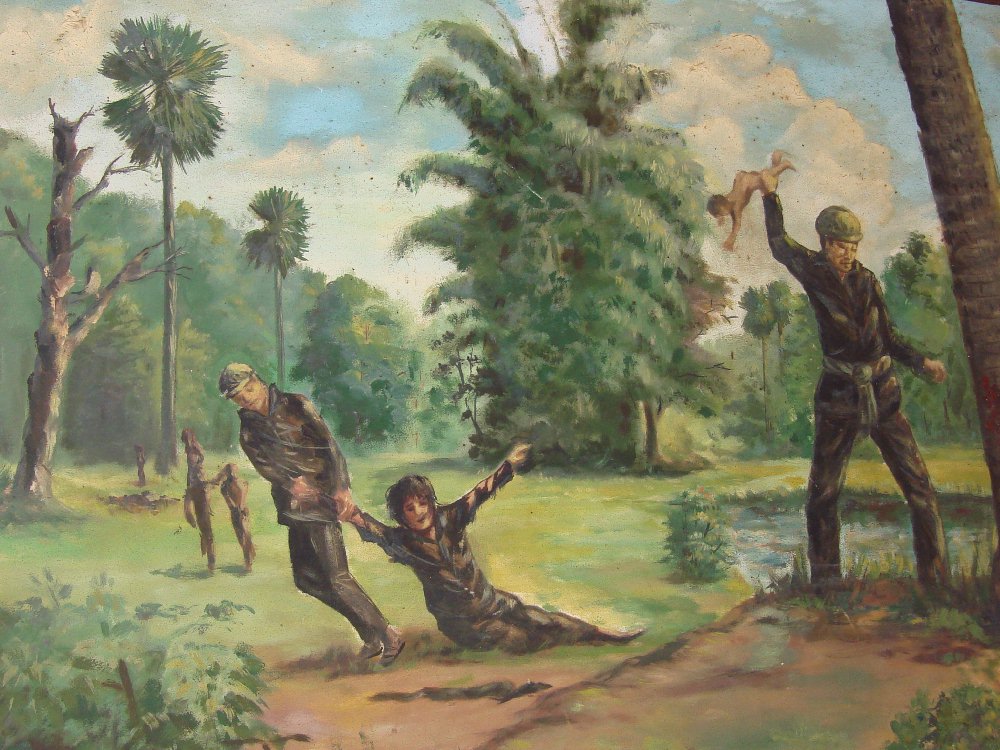 "It was very hard to make those Tuol Sleng paintings," he said of the 1980-81 series. "I felt like I was living through it all again." His work in the Legacy exhibition stands in stark contrast to many of the other bleak images. Nath chose to contribute a painting of an idyllic rural scene: a farmer relaxes under the shade of a tree and plays his pipe, surrounded by lush greenery and deep blue skies.
"Ever since the war, the farmers have been afraid," he explains. "There are thieves, and there are land mines. I am trying to create a picture of the ideal, for the countryside to have freedom at its heart." He shyly acknowledges that the painting is a self-portrait, saying it is for his grandchildren. "I want them to know that I went through it all and I am still strong." "There has been too much suffering here," he continues. "Now I want to think about independence and freedom and beauty. I am always prepared to do my duty as a witness, but in art, I want to paint landscapes and beauty." For Cambodia, the very presence of such an exhibition is at least a small step forward in the healing process. Nearly every single family in Cambodia suffered losses during the regime, from starvation, execution, or disease; the final death count stands at around two million people. Part of the healing for those left behind is coming to understand how they can live with that "absence." "How do we deal with this heritage?" asks Daravuth, who admits that even though he lived through the Khmer Rouge years, he cannot get a full, coherent grip on what happened to him. "With heritage like Angkor Wat, you have conservationists, picture painters, and so on. But the Khmer Rouge regime can't be classified-like a UNESCO world monument-there's nothing there. You have to find another way."
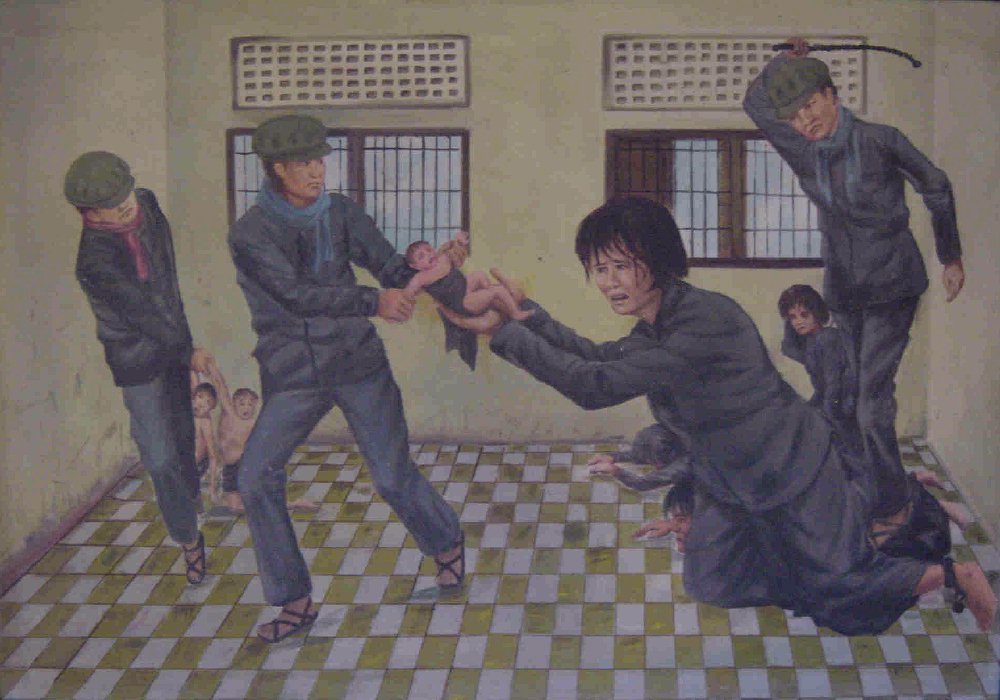
| |
